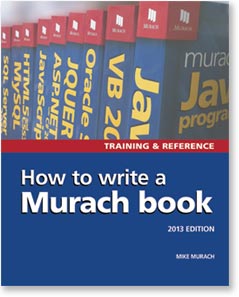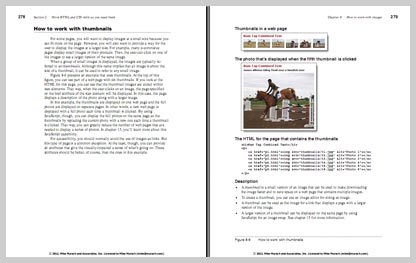What We Do Differently
What do we do that’s different from other textbook publishers? The short answer is: Just about everything. But here are a few of the ways in which we differ.
It may sound hard to believe, but we don’t know of another textbook publisher that has an inhouse manual for authors and editors that shows how to do every phase of writing a book and developing courseware.
Oh sure, most companies will have a "style manual” that covers subjects like how to capture screens and how to format captions, callouts, new terms, and computer code. And they will also have a standard for what the end-of-chapter activities must include. But you can get all of that right and still end up with a book that doesn’t teach the skills that the title promises.

Our inhouse manual, How to Write
a Murach Book, provides detailed
guidelines for doing every phase
of writing a Murach book.
In contrast, our inhouse manual, How to Write a Murach Book, provides detailed guidelines for every phase of developing a Murach book, including:
- How to develop the table of contents for a book
- When and how to develop the applications for a book
- How to plan the contents for a chapter
- How to develop the figures that storyboard each chapter
- How to write the first draft of the text for each chapter
- How to develop the exercises for each chapter
- How to prepare the final draft of each chapter
It also provides detailed guidelines for developing courseware, including:
- How to prepare behavioral objectives
- How to prepare test banks
- How to develop exercises and projects
- How to prepare PowerPoint slides
As we see it, those are the critical skills that authors need to learn before they write texts, and certainly before they write a Murach book.
Our writing methods continue to improve
Mike wrote the first version of our inhouse writing manual way back in the 80s, under the title Structured Technical Writing. But we continue to refine and improve those methods. In fact, we like to think that we’ve learned something from every author we have worked with.
About 20 years ago, for example, we realized that there was something wrong with almost all technical books, including ours. The problem was that readers had to dig out the skill-building information that they needed from pages heavy with text. Then, to review that information, they had to dig it out again. That’s when we developed a new presentation method that we now call paired pages.

“Paired Pages” example. Enlarge
With our paired-pages method, each topic is presented in a two-page spread. The page on the right presents the examples, coding, and critical skills that you need to master, and the page on the left explains and enlarges upon that as needed. The result is that you read less and learn faster. And when you’re done with the book for training, this is the perfect format for on-the-job reference…which is why so many instructors report that their students not only buy our books, but keep them after the course ends.
Today, we use our paired-pages presentation method in all of our books, and we’re the only publisher that does. That of course gives our books a distinct advantage over all of the competing books. But honestly, that’s only one of the reasons why our books work so well.
We believe that the best practices for on-the-job training apply to college instruction
For many years, the best companies have agreed on the best practices for on-the-job training. Those practices include:
- Starting with a task analysis of the skills needed on the job
- Developing behavioral objectives that describe what the trainees should be able to do when they complete a course
- Developing the instructional materials that teach the skills that the behavioral objectives describe
- Developing the exercises that let the trainees practice the skills
- Developing the projects that test whether the trainees have mastered the skills
To us, these practices have always made sense, so we’ve used them from the start as we’ve developed books and courseware.
Of course, academic instruction differs from on-the-job training, but we believe that these principles can and should be applied to academic instruction too. We think that’s especially true for computer courses because they should always have a real-world component. Otherwise, the courses are misleading the students.
We never copy what we see in competing textbooks
Mike was 29 when he started writing his first textbook as a freelance writer, and he sometimes wondered how he could be bold enough to think that he could write the best textbook on his subject. Was he fooling himself?
To keep himself going, though, he kept the five best-selling textbooks on the subject in a chair next to his desk. And whenever his confidence faltered, he would page through them, noting everything that was wrong with them as he paged. Before long, he would think: “If I can’t write a better book than that, something is really wrong with me,” and back to the typewriter he went.
Today, everyone on our staff feels that way. As a result, we never are tempted to copy what we see in competing textbooks because we simply don’t believe it works. In fact, we believe that most textbooks are an affront to higher education. And that goes from the instructional objectives at the start of each chapter to the student activities at the end. Come on, textbook authors and publishers, you can do better than that.
Curiously, though, copying is so common in the textbook publishing industry that they even have terms for it, like “me-too publishing” and “proliferation publishing.” Our question is, why would you want to copy any aspect of a competing textbook when there’s so much room for improvement?
We are dedicated to improving education
Like it or not, it’s pretty clear that most textbook publishers are dedicated to selling textbooks, not to improving education. In other words, they’re in the book business, not the education business. That’s why textbooks haven’t improved in the 50+ years that we’ve been in business. And it’s tough to create and run effective courses based on ineffective texts.
In contrast, we get our kicks from making better books, and you can only do that if you’re dedicated to improving education. We think that’s a good business model too: Make a better book, get a fair share of the market by doing so, take pride in what you’re doing, have some fun along the way, and stay in business for 50 years. That’s obviously not for everybody, but for us it’s a way of life.




